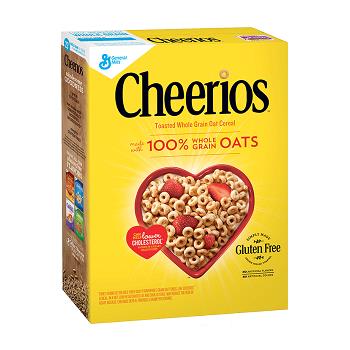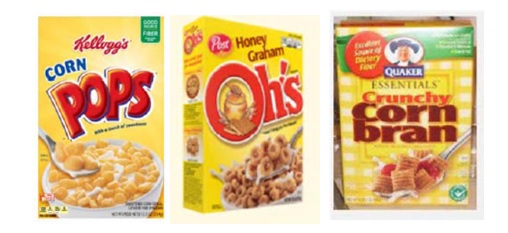
General Mills Finds Out That Yellow Is Not “Magically Delicious”: Brands Fighting To Protect Their True Colors
Edited by Loni Morrow and Catherine Holland
Years after the Christian Louboutin v. Yves Saint Laurent battle over red soled shoes, trademark protection for color continues to be a hot topic. On August 22, 2017, the Trademark Trial and Appeal Board (“TTAB”) held that General Mills was not entitled to a trademark registration for its yellow Cheerios’ box shown below:

This case is a good lesson for fashion brands to understand what evidence they will need to obtain a federal registration for a color mark.
“Gotta Have My Color!”
General Mills applied to register the mark  in connection with “toroidal-shaped, oat-based breakfast cereal.” Because color can never be inherently distinctive, a brand owner applying for trademark protection for a color must show that the color has acquired distinctiveness, meaning consumers have come to recognize it as a source indicator for that brand. See Wal-Mart Stores, Inc. v. Samara Bros., 529 U.S. 205, 212 (2000). In other words, when a consumer sees a yellow cereal box, the consumer immediately associates General Mills as the source of the cereal. Some classic examples of color marks are pink for Owens Corning’s insulation for construction projects and yellow for Caterpillar’s construction equipment.
in connection with “toroidal-shaped, oat-based breakfast cereal.” Because color can never be inherently distinctive, a brand owner applying for trademark protection for a color must show that the color has acquired distinctiveness, meaning consumers have come to recognize it as a source indicator for that brand. See Wal-Mart Stores, Inc. v. Samara Bros., 529 U.S. 205, 212 (2000). In other words, when a consumer sees a yellow cereal box, the consumer immediately associates General Mills as the source of the cereal. Some classic examples of color marks are pink for Owens Corning’s insulation for construction projects and yellow for Caterpillar’s construction equipment.
General Mills claimed that its yellow Cheerios box had acquired distinctiveness and, thus, it was entitled to a trademark registration. In some cases, five years of substantially exclusive use is prima facie evidence of acquired distinctiveness. In cases involving color, however, an applicant must submit much more than a claim of over five years of use.
General Mills submitted extensive evidence to back up its claim of acquired distinctiveness. This evidence included continuous use of the yellow Cheerios box since 1945. Also, General Mills spent $1 billion in marketing featuring the yellow Cheerios box, and it had $4 billion in sales of the yellow Cheerios box for the time period 2005 to 2015. Further, General Mills submitted evidence of extensive television advertising featuring the yellow box and recognition of the yellow box in publications such as USA Today. General Mills even submitted a consumer survey showing that 48% of respondents associated the yellow box with Cheerios. Recognition percentages such as 48% and 37% have previously been found sufficient to show acquired distinctiveness. Warner Bros. Entm’t v. Global Asylum, Inc., 107 U.S.P.Q.2d 1910, 1914 (C.D. Cal. 2012), aff'd, 544 Fed. Appx. 683 (9th Cir. 2013) (secondary meaning of the HOBBIT mark was shown by a survey of 400 respondents, 48% of whom associated the word with Tolkien properties); Monsieur Henri Wines, Ltd. v. Duran, 204 U.S.P.Q. 601 (T.T.A.B. 1979) (37% of interviewees associated the Monsieur Henri Wines brand with a background design, and this percentage was sufficient to show the design had acquired distinctiveness). As substantial as General Mills’ evidence appears, both the Examining Attorney and the TTAB were not impressed. The TTAB held that the evidence was insufficient to prove yellow for cereal had acquired distinctiveness.
“TTAB Tested, TTAB Dis-Approved.”
So why didn’t General Mills get its trademark registration? The TTAB held that there were too many other breakfast cereals sold in yellow boxes for the yellow box alone to serve as a source identifier for Cheerios. Some examples of other cereals packaged in yellow boxes identified by the TTAB are shown below:

The TTAB said that customers look to the wording and graphics on the cereal box to know what brand they are buying. The yellow packaging is just “eye-catching ornamentation.”
It didn't help that General Mills sells Cheerios in different color boxes to denote different flavors. For example, Multi-Grain Cheerios are sold in a purple box and Frosted Cheerios are sold in a blue box.

Thus, customers may perceive the various colors as suggesting something about the nature or flavor of the cereal, rather than as a source identifier.
“The Color of Champions”
Even though the TTAB refused trademark registration for the yellow Cheerios box, the TTAB reassured brand owners that “there is no doubt that a single color applied to a product or its packaging may function as a trademark and be entitled to registration under the Trademark Act.” But if the yellow Cheerios box does not act as a source identifier, then what does? As you may recall, Christian Louboutin successfully obtained a U.S. trademark registration for its red shoe sole. However, its trademark registration is limited to a red lacquered outsole that contrasts with the color of the upper portion of the shoe. Tiffany & Co. successfully obtained a trademark registration for its robin egg blue jewelry pouch, boxes, and bags. Hermes obtained a trademark registration for its orange gift boxes for perfumes, jewelry, handbags and clothing.
“Silly Rabbit, Color Marks Are For Brands With Substantially Exclusive Use!”
Based on the TTAB’s decision in the Cheerios case, it is clear that evidence of extensive use, sales, and advertising will not be enough to overcome widespread industry use of that color. If a brand owner wants to protect a certain color, it is important that it select a color that is not already used by its competitors. The brand owner should keep records of its own use, sales, and advertising, and also stop others from using the color. Enforcement may be difficult, however, unless the brand owner obtains a trademark registration for the color. Unfortunately, this may also be difficult, because the brand owner must submit proof that it has made extensive, and substantially exclusive, use of its mark. It is a Catch 22 situation. It may be easier to obtain trademark protection for a color if the brand owner can identify something unique about its use or the position of the color, i.e., it is in contrast to the upper portion of the shoe.
In general, it can be difficult to obtain exclusive rights in a color mark, and also difficult to enforce those rights against others. It may be worth the effort, however. Color can serve as a strong source identifier for a fashion brand. Once established, it can become a long lasting symbol of the brand, with strong consumer recognition.
